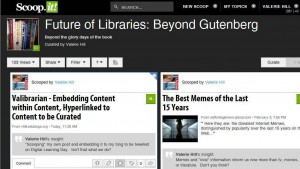Quit bashing teachers! Quit saying “it is time for a change in education.”
My teachers are awesome…..Enough said!
If it is time for change– Go ahead and change. I already have. So have my students. So has our world.
I work with an amazing group of educators. Every day I see how much they care for students. They go above and beyond expectations by listening to each student, providing materials and projects, laughing with them and crying with them. As a school librarian, I am fortunate to see everyone and I can say firmly, from personal observation, my school has amazing, outstanding teachers. Yet, we hear in the news “we need better teachers” and “education needs to change”.
Education has always been full of change. But now there is something even more radical than changing pedagogies.
What’s the big change?
The change is us. All of us. Society is now driven by user-generated content instead of content created by experts in various fields. We now create our own content. We now are prosumers (both producers and consumers of content).
What do I mean by that?
We can be journalists by blogging (blogs are more popular today than newspapers). We can be film-makers (upload it to YouTube). We can be content curators (Scoop-it). We can be artists and musicians (there’s an app for that! Have you tried garage band or Voiceband?). We can each be a librarian (Pinterest? or tons of other curation sites?) But wait– is intellectual property still relevant? Is there a problem when we all think what we create is simply wonderful? Is there a problem when we follow those with similar interests and beliefs and never challenge our opinions by bouncing them off the perspectives of others?
If you are still reading along, and the odds are you are not because most blog posts are short (average of 12 seconds on each page hit by a user), you may be confused when I call this radical change “the toppling of the information hierarchy”. We are witnessing a moment in time that is as important as the invention of the Gutenberg press. This toppled hierarchy of information means we can no longer teach the students skills for learning in the old hierarchy. How do we teach them survival skills in (what I refer to as) the sea of online chaos?
Having considered this topic for a few years, perhaps I can share a few tips for teachers.
1. Care for your students. Wow! That is still top priority and that is what I am fortunate to see every day. This genuine love for students and love of learning is more important than the following points. Yet, I encourage you to read on for survival of the online tsunami.
2. Strive to promote 21st century information literacy. What you learned in your academic career no longer applies. The new literacy (transliteracy- if you want to think in a new way) includes physical, virtual, and augmented content. Information literacy is now an ongoing personal responsibility instead of a skills-based checklist. YOU must decide who to learn from (who to follow online in the new hierarchy) as an educator and as a digital citizen living through the digital revolution. As a teacher, you must also instill that personal responsibility in your students. Digital citizenship is as important as physical manners, some may argue even more so as it impacts a much greater community.
3. Balance the pendulum. What is that? Balance has always been important, since education began. But now we must balance the physical with the virtual– tradition with innovation– teamwork with individuality — privacy with free speech –personal voice with crowd-sourcing — and the list goes on.
4. Do not be afraid. Some will cry, “What is this world coming to?” and some will say, “I wish we could go back to the way it was.” Don’t listen. Go back to point 2 and seek out those people who can help you learn 21st century information literacy skills, whether in person or across the globe (I have learned from many virtual colleagues). Then, reread point 3 and take a deep breath as you balance your steps on this amazing journey we call human life. Each one of us breathing, growing, and learning. Rather than fear the future, I choose to be hopeful and joyful. Dare I mention what gives me hope and joy? Dare I risk someone reading this to the final last word that nullifies all fear and all bullet points in any educator’s presentation on the latest Web 2.0 platform?
Faith
